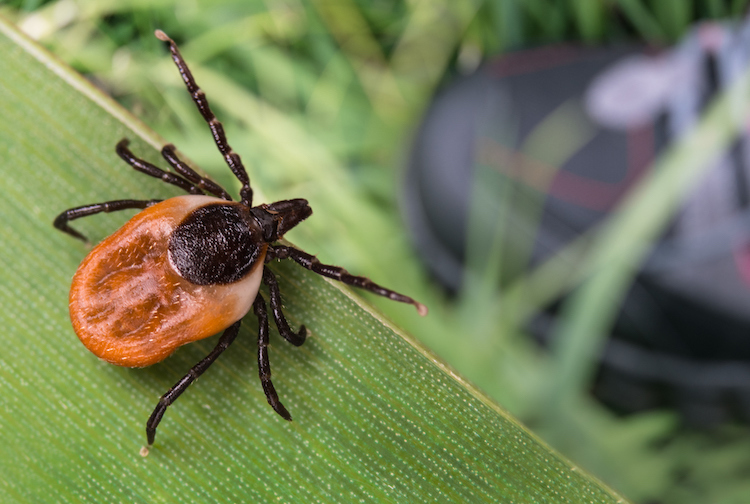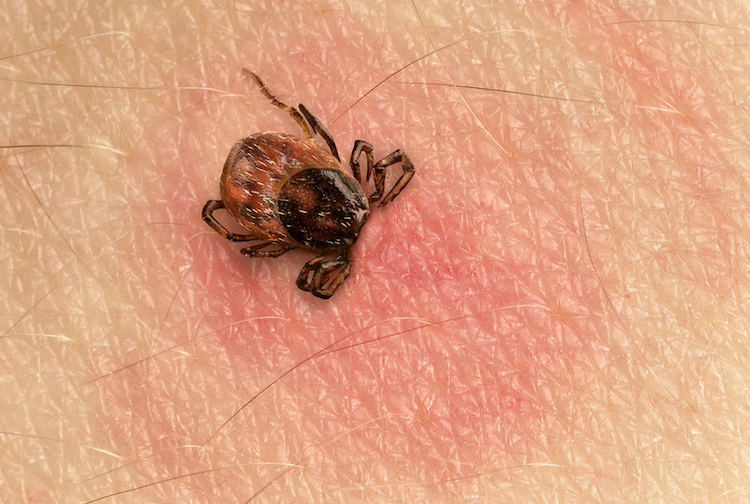
Summer Safety: How to tell if you have Lyme disease
Keep an eye out for ticks and prevent Lyme disease infections with tips from VCU experts.
June 23, 2023 Ticks, the carriers of Lyme disease, make their homes in wooded areas. (Getty Images)
Ticks, the carriers of Lyme disease, make their homes in wooded areas. (Getty Images)
By Jayla Parker
Health experts are urging outdoor enthusiasts to be extra vigilant this summer because of a small critter with a powerful bite.
Virginia is one of more than a dozen states with significantly high cases of Lyme disease in the United States.Ticks are carriers of this disease. They make their homes in wooded areas with lots of shrubs, tall grasses, weeds, woodpiles and even bird feeders. These parasitic arachnids — relatives of spiders, scorpions and mites — need to feed on blood to survive and can spread illnesses to humans and animals.“
Ticks are a great concern for several reasons, and they're an increasing concern because their population is spreading quite rapidly,” said Richard T. Marconi, Ph.D., professor in the Department of Microbiology and Immunology at Virginia Commonwealth University’s School of Medicine.
A wide variety of things can affect the size of the tick population, including the weather and how many small mammals there are in a wooded area.
“When we have mild winters like the one that we just did in Virginia, the tick population tends to explode. So I expect that this year it's gonna be rather robust,” Marconi said.
Marconi, who is internationally known for his research on vaccines for tick-borne illnesses, shared tips with VCU Health News for our Summer Safety Series on how to TICK all of the boxes on our safety checklist.
How many ticks carry Lyme disease and other tick-borne illnesses?
In Virginia, about 15% of ticks carry Lyme disease. Although ticks are active all year long, Virginia’s peak months of tick season are in June and July.
While there are several different types of ticks that each carry a different disease, the chances of contracting a tick-borne infection is relatively low. That’s because a low percentage of ticks are actually carrying any disease.
The specific ticks responsible for carrying Lyme disease are known as the Backlegged tick or Deer tick across the East Coast and the Western Blacklegged tick on the West Coast.
In order to fully transmit Lyme disease inside of a human’s or animal’s body, it must feed for at least two to three days, but other infections, like the Powassan virus disease, can transmit within a few hours.
Other tick-borne illnesses can include ehrlichiosis passed by the Lone Star Tick, Rocky Mountain spotted fever passed by both the American Dog Tick and Rocky Mountain Wood Tick, and Powassan virus disease transmitted by the Groundhog Tick.
What should I do if I find a tick on my body or someone else’s?
If you see a tick on your body or on someone else you’re with, stay calm.
- Gently remove the tick using a fine pair of tweezers
- Save the tick
- Monitor the tick bite area for any changes
Although it may sound odd, providers and researchers highly suggested you save the tick that bit you in a plastic bag or a small jar with rubbing alcohol. Saving the tick that bit you could help a clinician assess the type of tick-borne disease you’ve contracted by first examining the tick.
If you're bitten by a tick and you save it, you can send it to the Virginia Department of Health’s Tick Survey Program, where state health experts will examine the tick and notify you of any concerns.
What does a tick bite look like?
A tick carrying no illness can still bite you, but they do not pose a severe threat to your body. It is common to develop a small bump or redness immediately after being bit. If that tick does not carry an illness, then the irritation should be gone within 1-2 days like any other common bite from an insect.
We refer to a Lyme disease rash as a bullseye rash. The difference between a bullseye rash and a regular tick bite is that the bullseye rash can gradually expand over several days reaching up to 12 inches or more.
Once you’ve identified any type of rash or irritation from a tick bite, the best thing to do is simply wash it with soap and water and document the rash daily by taking pictures of it everyday with your cell phone.
As the days go by, if you notice the rash is expanding, then it may be an indication that you've been infected with the Lyme disease bacteria and should contact your primary care provider.
Red blotches around a tick bite indicate a potential infection. (Getty Images)
What is Lyme disease and how is it treated?
Diagnosing Lyme disease can be a challenge because this illness mimics so many other conditions we just generally experience and don't seek treatment for. Some of these symptoms include:
- Fever, chills, headaches, fatigue, dizziness
- Arthritis with severe joint pain and swelling
- Heart palpitations
- Shooting pains in the hands or feet
- Inflammation of the brain
Symptoms of Lyme disease can show up as early as 3 to 30 days after the tick bite, or months afterwards, depending on the person or animal.
In the vast majority of cases, Lyme disease can be successfully treated. Patients are often given antibiotic treatment in the form of pills, but when a patient has had Lyme disease for quite some time, intravenous antibiotics and treatment of symptoms can be used.
There are rare cases where Lyme disease can be fatal if it's not diagnosed early or other complications occur as the result of an infection. There are documented cases of patients who have died of what we call Lyme carditis, which is inflammation of the heart as a result of Lyme disease.
Overall, if you're not feeling well and you don't have an explanation for your symptoms, talk to your primary care provider as soon as possible.
How can I protect myself?
There are many things you can do to protect yourself from ticks. If you are going on a hike or exploring a wooded area, consider some of the following tips:
- Be aware of the type of terrain you're going into and whether it's likely to harbor ticks.
- Wear light clothing so that you can see the ticks if they get on your clothes.
- If you’re wearing loose pants, tuck your pants into your socks.
- When you're done hiking or gardening or doing your activities outdoors, do a quick tick examination.
- Vaccinate your dog.
Unfortunately, there is no vaccine available at this time to prevent tick-borne illnesses. Researchers are working aggressively to transform the vaccine made for pets to be used on humans. In the meantime, we encourage everyone to remember that you live in a region with high tick populations.




